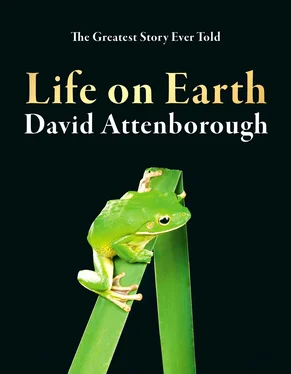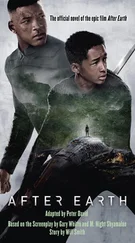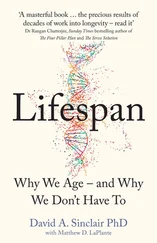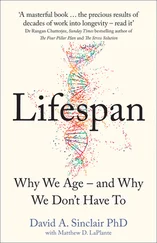Annelids have grooves encircling their body that correspond to the internal walls that divide its interior into separate compartments. Each of these is equipped with its own set of organs. On the exterior and on either side, there are leg-like projections sometimes equipped with bristles, and another pair of feathery appendages through which oxygen is absorbed. Within its body, each segment has a pair of tubes opening to the exterior from which waste is secreted. A gut, a large blood vessel and a nerve cord run from front to end through all the segments, linking and coordinating them.
Fossils can only tell us so much. Even the exceptionally well-preserved remains of Ediacara offer no clue about the connection between the segmented worms and the other early groups. However, there is one further category of evidence to be looked at – the larvae. The segmented worms have spherical larvae with a belt of cilia round their middles and a long tuft on top. These are almost identical to the larva of some molluscs, a strong indication that back in time the two groups sprang from common stock. The echinoderms, on the other hand, have a larva that is quite different, with a twist to its structure and winding bands of cilia around it. This group must have separated from the ancestral flatworms at a very early stage indeed, long before the split between the molluscs and the segmented worms. Geneticists, analysing the DNA of each of these groups, now confirm these deductions and reveal that there are two major groupings of bilaterally symmetrical animals. Octopus, crabs and flatworms form one group, while echinoderms, tunicates and all the backboned animals make up the other.
Segmentation may have developed as a way of enabling worms to increase their efficiency as burrowers in mud. A line of separate limbs down each side is clearly a very effective structure for this purpose and it could have been acquired by repeating the simple body unit to form a chain. The change must have taken place long before Ediacaran times, for when those rocks were deposited the fundamental invertebrate divisions were already established The Ediacaran fossils, in Australia where they were first discovered and in Britain, Newfoundland, Namibia and Siberia, now confirm these deductions. Thereafter their history remains virtually invisible for a 100 million years. Only after this vast span do we reach the period, 600 million years ago, represented by the Moroccan deposits and others throughout the world. By that time many organisms had, as we have seen, developed shells from which we can deduce their existence and shape, but not much more.
However, there is one exceptional fossil site dating from only a little later than those of Ediacara that provides far more detailed information about the bodies of animals than can come from mere shells. In the Rocky Mountains of British Columbia, the Burgess Pass crosses a ridge between two high snowy peaks. Close to its crest lies an outcrop of particularly fine-grained shales, and in these have been discovered some of the most perfectly preserved fossils in the world. The shales were laid down about 530 million years ago, close to the beginning of the Cambrian period in a basin of the seafloor at a depth of about 150 metres. It must have been sheltered by a submarine ridge, for there were no currents to disturb the fine sediments on the floor or to bring down oxygenated water from nearer the surface. Few animals lived in those dark stagnant waters. There are no signs of tracks or burrows. Once in a while, however, mud from the ridge above slipped down in a turbid cloud, carrying with it all kinds of small creatures, and dumped them there. Since there was neither oxygen to fuel the processes of decay nor any scavenging animals to feed on the bodies and destroy them, many of the tiny carcasses remained complete as the settling mud particles slowly entombed them, preserving even their softest body parts. Eventually the entire deposit became consolidated into shale. Earth movements elevated and folded great areas of these marine deposits during the building of the Rocky Mountains. Many parts of them were distorted and crushed until most traces of life in them were obliterated. But miraculously, this one small patch survived virtually undamaged.
Velvet worm ( Peripatus novaezealandiae ). Velvet worms are known as ‘living fossils’, having remained the same for approximately 570 million years.
The range of creatures it contains is far wider than that found in rocks of a similar age at any other site so far discovered. There are the jellyfish that Ediacara would lead us to expect. There are echinoderms, brachiopods, primitive molluscs and half a dozen species of segmented worms – further representatives of the lineage that stretches from the beaches of Ediacara to the Barrier Reef of today.
There are also several creatures which were rather more mysterious. Among the most abundant of these was a strange segmented creature with what seemed to be a line of legs on its underside. It looked rather like a shrimp, though mysteriously none of the species had a head. It was given the name Anomalorcaris : strange shrimp. There were also small disc-shaped fossils marked with lines radiating from its centre that looked somewhat like a tiny slice of pineapple, which was initially thought to be some kind of jellyfish. Perhaps strangest of all, there was an elongated segmented animal that appeared to have seven pairs of spiny stilt-like legs, and seven flexible tentacles along its back, each ending in a tiny mouth. It seemed so strange as to be almost nightmarish, and the researcher who studied it accordingly called it Hallucigenia .
Subsequent work, however, showed that these oddities were not the founder members of some wholly unsuspected animal groups. A very exceptional specimen of Anomalocaris showed that the ‘strange shrimps’ were not complete animals but just the forelimbs belonging to a much bigger creature that used them to grab its prey. And the pineapple slice was eventually shown to have in its centre minute teeth. It was a mouth that belonged to the same animal as the tentacles. Both these pieces of Anomalorcaris ’ body apparently had a more heavily strengthened exoskeleton and so regularly became separated from the animal’s more easily decayed body. As for Hallucigenia , further research on other specimens showed that it had been reconstructed in an upside-down position. The spindly legs were in fact protective dorsal spines, and what had been considered tentacles were in reality its legs. It is now thought that it may be the first known member of a strange group called the lobopods which today includes odd little creatures called velvet worms.
The great variety of creatures in the Burgess Shales is a reminder of how incomplete our knowledge of all fossil faunas actually is. The ancient seas contained many more kinds of animals than we can ever know. In this one site, conditions allowed a uniquely large proportion to be preserved, but even this is only a hint of what must have once existed.
The Burgess Shales also contain superbly preserved examples of trilobites like those in the Moroccan limestones. Their body armour was constructed partly of calcium carbonate and strengthened by a horny substance called chitin, a material that forms the external skeletons of insects. But chitin, unlike skin, does not expand, so any animal with such an external chitinous skeleton has to shed it regularly if it is to grow – as indeed insects do today. Many of the trilobite fossils we find are in fact these empty suits of armour. Sometimes they are concentrated in great drifts, having been sorted by sea currents, as shells sometimes are when they are swept up on beaches today. The underwater avalanches in the Burgess Shales Basin, however, swept down not just discarded armour but living trilobites and buried them. Mud particles filtered into the animals’ bodies and preserved the finest details of their anatomy. So in them we can still see the paired jointed legs that are attached to each body segment, the feathery gill associated with each leg, two feelers at the front of the head, and the gut running the entire length of the body. Even the muscle fibres along the back, which enabled the animal to roll itself up into a ball, are still recognisable in some exceptional specimens.
Читать дальше












